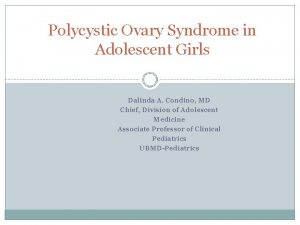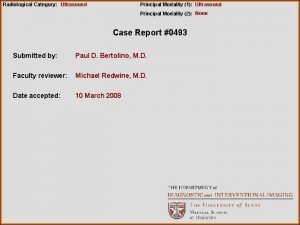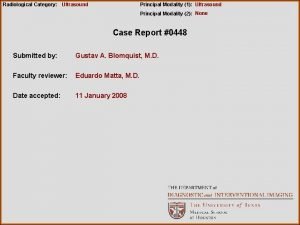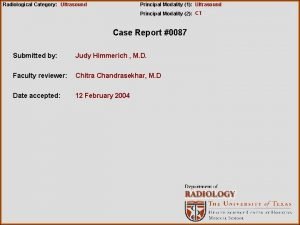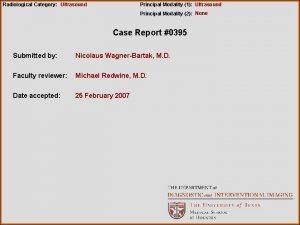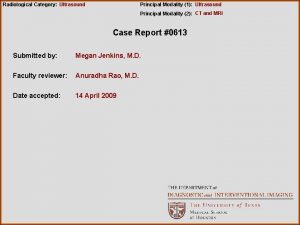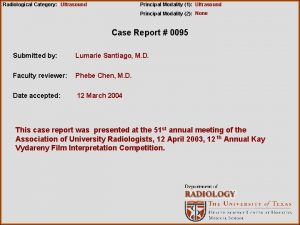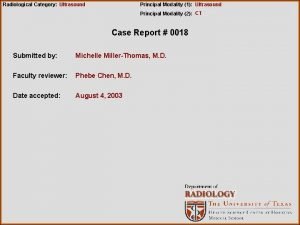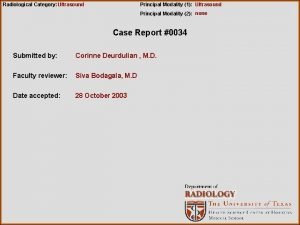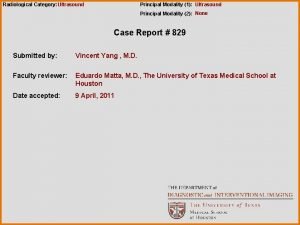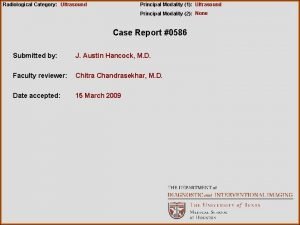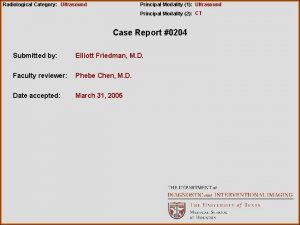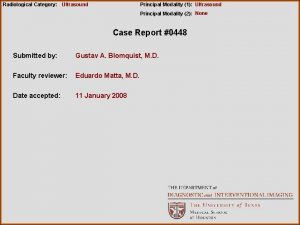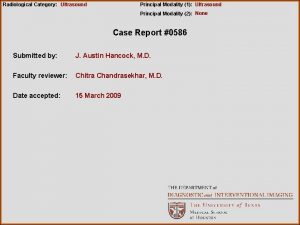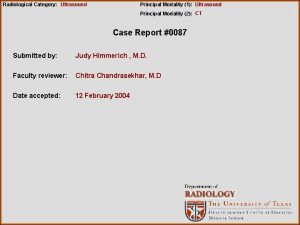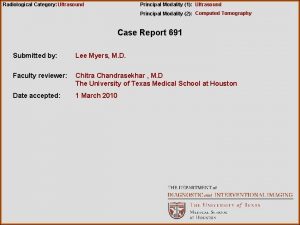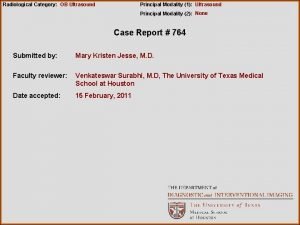Radiological Category Ultrasound Principal Modality 1 Ultrasound Principal























- Slides: 23

Radiological Category: Ultrasound Principal Modality (1): Ultrasound Principal Modality (2): None Case Report # 0931 Submitted by: Synda M. Vandenmooter, M. D. Faculty reviewer: Eduardo Matta, M. D. The University of Texas Medical School at Houston Date accepted: 15 March 2012

Case History 36 yo female with a positive pregnancy test presents with abdominal pain. EGA by LMP is 6 weeks and 5 days. Beta-h. CG is 7, 944.

Radiological Presentations Uterus Long

Radiological Presentations Right Adnexa Trans

Radiological Presentations Uterus Long

Radiological Presentations Uterus Trans

Radiological Presentations + Dist 0. 691 cm Uterus Long

Test Your Diagnosis Which one of the following is your choice for the appropriate diagnosis? After your selection, go to next page. • Normal intrauterine pregnancy • Too early to detect intrauterine pregnancy • Ectopic pregnancy without evidence of rupture • Ruptured ectopic pregnancy • Ruptured corpus luteum cyst

Findings and Differentials Findings: Transabdominal and transvaginal grayscale and color Doppler images of the pelvis demonstrate the presence of a small round anechoic structure and multiple hypoechoic structures in the uterus, but a normal endometrial thickness with an empty endometrial cavity. In addition, a round anechoic structure with a thick, echogenic, vascular rim is present in the right adnexa. The most striking finding in this case, although it may be the most elusive, is the presence of a large amount of echogenic material in the pelvis. It surrounds the uterus and the adnexa. Differentials: • Normal intrauterine pregnancy • Too early to detect intrauterine pregnancy • Ectopic pregnancy without evidence of rupture • Ruptured ectopic pregnancy • Ruptured corpus luteum cyst

Discussion Normal intrauterine pregnancy: Only a small amount of anechoic fluid should be present in the cul-de-sac in a normal first trimester pregnancy, which is not the case in this study. Also, at a gestational age of 6 weeks and 5 days (by LMP), we would expect to see a gestational sac with a MSD of about 16 mm and a fetus with a CRL of about 8 mm, both of which are not present. Too early to detect intrauterine pregnancy: The reasons stated above also apply here. In addition, the patient’s beta-h. CG level of 7, 944 is well above the discriminatory zone of 1800 – 2000, making this diagnosis very unlikely. The following images demonstrate a normal IUP at 6 weeks and 6 days gestation with normal MSD and CRL, as well as a small amount of anechoic free fluid in the cul-de-sac.

Radiological Presentations Free Fluid in Cul-de-Sac Gestational Sac Diam 1 1. 92 cm Sac Diam 2 0. 92 cm Sac Diam 3 2. 52 cm Fetus CRL 0. 8 cm 6 w 6 d

Discussion Ectopic pregnancy without evidence of rupture: Although the round right adnexal cystic structure is suggestive of the presence of an ectopic pregnancy, the more important finding is the large amount of blood in the pelvis. Failure to recognize this may result in delayed treatment and poor outcome. Even without direct visualization of the ectopic pregnancy, patients with evidence of bleeding require close follow up with/without surgical intervention. The following images demonstrate the classic ‘donut’ sign in the left adnexa consistent with a tubal ectopic pregnancy. There is complex fluid in the cul-de-sac and although it is a small to moderate amount, the possibility of rupture should be considered. This patient, however, was found to have an unruptured left tubal ectopic pregnancy with a small amount of hemoperitoneum.

Radiological Presentations Ectopic Pregnancy Long Left Adnexa Left Ovary Trans Left Adnexa Complex Fluid in Cul-de-Sac Long Trans

Discussion Ruptured corpus luteum cyst: The ruptured cyst itself will present as an intraovarian mass. It can be of mixed echogenicity and may contain lacy interstices due to the presence of blood. It often demonstrates the characteristic ‘ring-of-fire’ appearance on color Doppler and may be difficult to distinguish from an ectopic pregnancy in some cases, especially when the latter is located in the ovary itself or if it cannot be definitively separated from the ovary. When the cyst ruptures into the peritoneum, blood may be present in the cul-de-sac. In rare cases, the extent of hemorrhage may be so severe as to cause hemodynamic compromise and require surgical intervention. The following images demonstrate a large adnexal cyst with lacy internal echoes and a ‘ring-of-fire’, consistent with a hemorrhagic corpus luteum cyst. The complex fluid surrounding the right adnexa and in the cul-de-sac is indicative of rupture and bleeding into the peritoneum.

Radiological Presentations Long Right Ovary Trans Right Adnexa Trans Right Ovary Long Right Ovary Cul-de-Sac

Discussion Ruptured Ectopic Pregnancy An ectopic pregnancy occurs when a fertilized ovum implants in a site other than the endometrium. The most common location for this is the fallopian tube. In fact, 95 -97% of all ectopic pregnancies are found in the ampulla or isthmus. Other parts of the fallopian tube, the ovaries, the uterine cornua, the cervix, and the peritoneum are also possible sites for implantation, but this is rare. The typical triad of vaginal bleeding, abdominal pain, and a palpated tender adnexal mass in the setting of a positive pregnancy test are highly suspicious for the presence of an ectopic pregnancy. Women at increased risk for having an ectopic pregnancy include those with a history of prior ectopic pregnancy, those with fallopian tube abnormalities, and those undergoing assisted reproductive techniques. The most convincing evidence against an ectopic pregnancy on pelvic ultrasound is the detection of an intrauterine pregnancy. Although heterotopic pregnancies are possible, they are extremely rare (1 in 7, 000 pregnancies).

Discussion Clinically, the diagnosis of a ruptured ectopic is suspected when there are the additional symptoms of acute abdomen on physical exam, hemodynamic instability, and dropping hematocrit. Transvaginal ultrasound is often used to confirm this suspicion. Even without sonographic detection of the ectopic pregnancy itself, if there is no IUP, the detection of free fluid in the pelvis increases the likelihood of there being a ruptured ectopic pregnancy. This likelihood increases with larger amounts of fluid and the presence of echogenic fluid. However, one should also keep in mind that the presence of hemoperitoneum in the setting of ectopic pregnancy may be the result of bleeding from the fimbriated end of the tube. The patient may be hemodynamically stable. Studies have also shown that rupture can be present in the absence of free fluid. Therefore, the clinical status of the patient should remain the deciding factor when deciding between conservative management and surgical intervention. The salient finding in the featured case is highlighted on the next slide.

Radiological Presentations Blood in the cul-de-sac Uterus Trans Echogenic blood clots around the uterus Uterus Long

Discussion In this case, sonography revealed a large amount of clotted blood in the pelvis and labs showed progressive drops in hematocrit. The patient was appropriately taken to the operating room for exploratory laparotomy of a suspected ruptured ectopic pregnancy. 2000 m. L of blood with clots were suctioned from the patient’s abdomen and pelvis. The right fallopian tube was found to be normal. The left fallopian tube was found to contain an ectopic pregnancy that was bleeding from its rupture site. In retrospect, the left tubal ectopic pregnancy was not seen on the preceding pelvic ultrasound and the partially visualized round right adnexal cyst may have been a normal corpus luteum. Nevertheless, the most salient and prognostic finding in this case had been the large amount of hemoperitoneum. The following images belong to a different case of a ruptured ectopic, but demonstrate many of the same findings.

Blood around the uterus Radiological Presentations Uterus Trans Blood in the cul-de-sac Uterus Long Blood in Morrison’s pouch

Radiological Presentations Blood around the ovary Hematosalpinx Right Ovary Trans Left Adnexa Trans

Diagnosis Ruptured ectopic pregnancy with hemoperitoneum

References 1. William D. Middleton et al. The Requisites Series: Ultrasound, 2 nd Edition. 2004. 2. Mary C. Frates et al. Tubal rupture in patients with ectopic pregnancy: Diagnosis with transvaginal ultrasound. Radiology. June 1994; 191, 769 -772.
 Ferriman-gallwey score
Ferriman-gallwey score Erate pa
Erate pa National radiological emergency preparedness conference
National radiological emergency preparedness conference Radiological dispersal device
Radiological dispersal device Tennessee division of radiological health
Tennessee division of radiological health Center for devices and radiological health
Center for devices and radiological health Cardinality and modality
Cardinality and modality Cardinality and modality
Cardinality and modality Modality in software engineering
Modality in software engineering Modality microsoft services
Modality microsoft services Epistemic modality
Epistemic modality Birafs
Birafs Modality stats
Modality stats Modality
Modality Modality in software engineering
Modality in software engineering Epistemic modality
Epistemic modality Modality in software engineering
Modality in software engineering Data modeling fundamentals
Data modeling fundamentals Modality
Modality High modality examples
High modality examples Pacs modality workstation
Pacs modality workstation Short wave diathermy definition
Short wave diathermy definition Characteristics of sensory neurons
Characteristics of sensory neurons Sodality vs modality
Sodality vs modality
